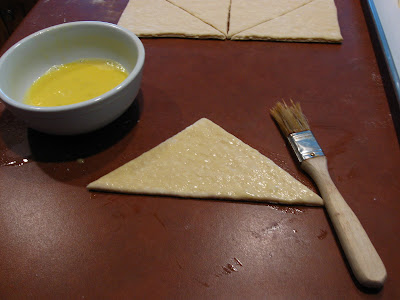 You reckon it's too late for a gal to decide she rather was enjoying her life of leisure before going back to full-time work? Whew! I forgot how much teaching can take out of you. Hopefully, before too long I'll get back in the groove. But for now, I'm feeling crazy! Fortunately, we still have to eat. And chopping and dicing and sauteing is still cathartic for me. For better or worse, this recipe does not involve any of those things, but I'll forgive it since it tastes so good.
You reckon it's too late for a gal to decide she rather was enjoying her life of leisure before going back to full-time work? Whew! I forgot how much teaching can take out of you. Hopefully, before too long I'll get back in the groove. But for now, I'm feeling crazy! Fortunately, we still have to eat. And chopping and dicing and sauteing is still cathartic for me. For better or worse, this recipe does not involve any of those things, but I'll forgive it since it tastes so good.My mom got this recipe from a friend of hers back when I was just a wee thing. It's another one of those recipes that are comforting to me. We ate it a lot... at heart, we are blueberry people. But don't feel limited to blueberries! Mix it up with whatever combination sounds good to you. You may have to adjust the sugar a bit, but that's no big deal.
This is a somewhat different recipe than those you usually see for cobblers. In fact, up until about four years ago, I thought this was a cobbler and couldn't for the life of me figure out why all those cobbler recipes I was trying weren't turning out "right". The name of "pudding" here is probably used simply to mean a dessert. Regardless, it is quick and simple and the result is fabulous!!
In an 8 x 8 baking pan, add the fruit, lemon juice and cinnamon.
 Then, in a small bowl, mix 1/4 cup of the sugar, butter, and milk together. Don't worry if it looks a little funky... it's all good.
Then, in a small bowl, mix 1/4 cup of the sugar, butter, and milk together. Don't worry if it looks a little funky... it's all good. Add the flour, baking powder, and salt to the butter mixture. Spoon it over the fruit as evenly as possible. It's a bit tricky because it's thick; I recommend using two spoons to spread it around.
Add the flour, baking powder, and salt to the butter mixture. Spoon it over the fruit as evenly as possible. It's a bit tricky because it's thick; I recommend using two spoons to spread it around. Next, it's time to sprinkle a mixture of cornstarch and sugar over the top of the whole deal.
Next, it's time to sprinkle a mixture of cornstarch and sugar over the top of the whole deal. The last step is to pour a cup of boiling water over everything. Looks kind of strange, doesn't it? Don't worry though, it will turn out fabulous.
The last step is to pour a cup of boiling water over everything. Looks kind of strange, doesn't it? Don't worry though, it will turn out fabulous. Bake in a 375 degree F oven for one hour. Look how wonderfully golden that top looks! Don't be fooled to pull this thing out of the oven early. It will start browning before it's actually ready... go the full hour. Let cool slightly before serving so that the fruit filling can thicken up a little bit.
Bake in a 375 degree F oven for one hour. Look how wonderfully golden that top looks! Don't be fooled to pull this thing out of the oven early. It will start browning before it's actually ready... go the full hour. Let cool slightly before serving so that the fruit filling can thicken up a little bit.
Blueberry "Pudding"
Yield: 6 servings
2 1/2 to 3 cups blueberries (or other fruit)
juice from one lemon
1/2 tsp ground cinnamon
Put fruit into an 8 x 8 baking dish. Add the lemon juice and cinnamon, sprinkling both evenly over the top. Meanwhile, preheat the oven to 375 degrees F.
1/3 cup sugar
3 TBS butter, melted
1/3 cup milk
Cream the sugar and butter together. Add the milk and whisk together. It may look lumpy and strange. Don't worry about that; it's normal.
1 cup flour
1 tsp baking powder
1/4 tsp salt
Sift together and then mix into the butter and milk mixture. Stir until it is smooth. Using two spoons, spread the batter evenly over the fruit.
1 TBS cornstarch
1/3 cup sugar
Mix the cornstarch and sugar together and sprinkle over the top of the fruit and batter.
1 cup boiling water
Pour the boiling water over the entire top of the batter, trying to wet the entire surface. Do not stir. Bake for one full hour at 375 degrees F. Cool slightly before serving so the fruit filling can thicken slightly. Serve plain or with vanilla ice cream or whipped cream.











































